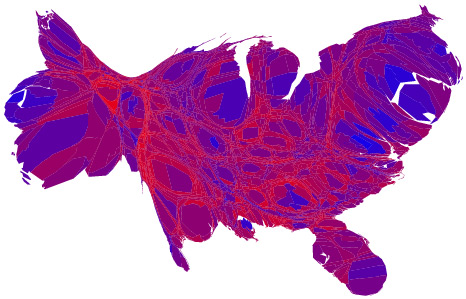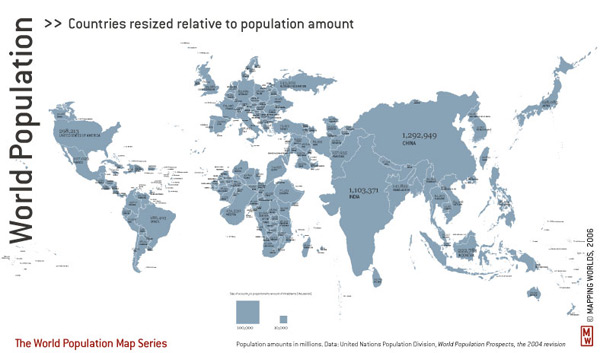I hate your favorite election map
I am not by nature an angry person—in fact my friends at times find me irritatingly even-tempered—nor am I known to truly hate anything, but provocative titles have their place, right?
We’ve once again arrived at that special time of (every fourth) year when the internet abounds with maps, charts, and other graphics attempting to depict and analyze every geographic and demographic angle of the US presidential election. I am happy for these, both in the perspectives they provide on the election and in the demonstration of interesting visualization methods.
But as a cartographer in the eternal quest for the Perfect Map, I find myself complaining about some map and graphics. In particular, I take exception to this:

For anyone who doesn’t know, the above is a cartogram (’bout time I wrote about that which my site is named after!) of the United States, in this case a map by Michael Gastner, Cosma Shalizi, and Mark Newman showing the results of the 2004 presidential election by county (we’ll soon be seeing one for 2008). A cartogram is a map that does not strive for geographic accuracy, but rather in which the area of units actually represents some value. In the election map, each county’s size represents its number of voters. The point of the map is to show that while a geographic red-blue election map would show an apparent vastness of Republican votes, those “red” areas actually account for about the same number of votes as the tiny “blue” areas. (The message is further conveyed by coloring counties along a red-blue continuum to show the actual balance of votes rather than simply coloring by the winner, something first seen in Robert Vanderbei’s election maps.)
I’ve written several drafts of many paragraphs to try to explain my opinion, but really, who has time to read all my ranting? Short version: apologies to Drs. Gastner and Newman, but as a cartographer interested in clear and effective design, I really believe that cartograms generated from their method are severely over-hyped and far more popular than they should be. Consider the election map (or any number of examples)…
- Ugly! All that puckering and bloating… I wouldn’t want to share an elevator with that America.
- Topology preservation at the expense of shape: even if I know what a county looks like on a normal map, I’m going to have a hard time identifying it here.
- On shape, still: curvy shape distortions are harder to recognize than simplified polygonal shapes.
- The overall distortions leave me gleaning only about five things from this map: east, west, Florida, Michigan, and that there is roughly the same amount of blue as red. Yes, I know that last one is the whole point, but if I can barely discern the geography, why bother to use a map? There are lots of cool visualization works that deserve attention too.
- Fast and easy cartograms (including this particular map) are not useless, and the work by Gastner and Newman is an important contribution, but there are under-appreciated careful designs out there. Consider the excellent cartograms from Mapping Worlds:

The bottom line is that many—perhaps even most—cartograms are essentially used for shock value, for the “holy crap, that’s a different perspective!” response, which is exactly what they get. Too frequently they can’t stand as maps on their own. I think the election cartogram is only of use when it’s next to an undistorted map. The best maps and graphics are those that tell their story clearly and elegantly, not those that simply evoke an emotional response. There are a million good reasons why I’m wrong to complain, but rather than going on and on in an attempt to counter them I will simply acknowledge that they exist and expound later if necessary.
“Put your money where your mouth is, jackass!”
Oh, actually that’s a pretty important reason I’m wrong to complain. Okay, I promise I will attempt to come up an alternative visualization of the same information as that election cartogram, as soon as I figure out where people find such detailed election data so quickly. (And, as I stressed “careful design,” it’s not going to be instant.) I’ll also keep an eye out in the coming days for maps and graphics that I think are more effective.
Having deleted most of what I previously wrote for this post, I wasn’t left with a good place to bring it up, but I must, as I seem to do in nearly every alternate post, refer to the work of my mortal enemy Zachary Johnson, who wrote his master’s thesis on cartogram designs in political maps. (He should be writing about this stuff. Maybe someday he’ll at least finally write about his findings. Eh, Joncy?) At the University of Wisconsin-Madison, specifically in room 412 Science Hall, we did not take cartographic research seriously if it could not be depicted by a cube. As such, Zach defined a cartogram typology (Cartogram3) by three characteristics: shape preservation, topology preservation (the preservation of boundaries and connectivity), and density equalization (essentially, how accurately area corresponds to value). No cartogram can be perfect in all three, and in fact most compromise all three to some degree. Zach tested several designs, each making different sacrifices, in political map-reading tasks. Note that I have bitched about shape preservation versus topology preservation. His research backs me up in some respects, but not in others. But I’m not in academia anymore; I don’t need “research” to know that I’m right!
Tagged cartograms, election maps, rants

11 Comments